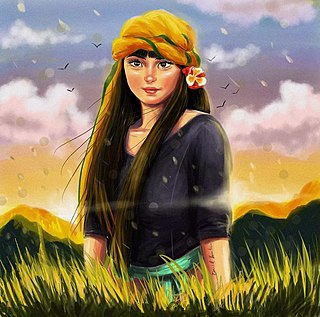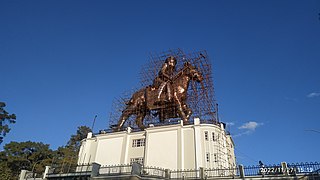
Sanamahism, also known as Meiteism, or Lainingthouism is an ethnic religion of the Meitei people of Manipur, in Northeast India. It is a polytheistic religion and is named after Lainingthou Sanamahi, one of the most important deities of the Meitei faith. Sanamahi is the eldest son of the supreme god Sidaba Mapu and the supreme goddess Leimarel Sidabi. Traditionally every Meitei household, irrespective of the religion, worships Sanamahi and Leimarel Sidabi. Sanamahism does not have a religious head but has a body, the Maru Loishang, that oversees the main religious activities and governs all affairs of the religion, including the conduct of priest and priestess. The Maru Loishang also acts a court for religious disputes. There are three main departments under the Manu Loishang, namely, the Amaiba Loishang, the Pena Asheiba Loishang, and the Amaibi Loishang. These departments have existed since the reign of King Meidingu Hongnemyoi Khunjao Naothingkhong of Manipur in 662 AD. Sanamahi is the eldest son of the supreme god Sidaba Mapu and the supreme goddess Leimarel Sidabi.
Here is a list of glossary of culture of India in alphabetical order:

Pakhangba is a primordial deity, often represented in the form of a dragon, in Meitei mythology and Sanamahism, the indigenous religion of Manipur. He is depicted in the heraldry of Manipur kingdom, which originated in paphal, mythical illustrations of the deity. It is believed that the ancestor of one of the Meitei clans manifested himself as the Pakhangba.

Imoinu or Emoinu is a goddess associated with household, hearth, family, fireplace, kitchen, wealth, peace and prosperity in Meitei mythology and religion of Ancient Kangleipak. She is frequently associated with Leimarel Sidabi. She is regarded as one of the incarnations or representations of goddess Leimarel Sidabi.

Leimarel Sidabi or Leimalel Sitapi is a goddess in Sanamahism, the indigenous religion of Manipur. She is the highest female divinity in the Meitei pantheon. She is the goddess of earth, of nature and the household. She is revered as the mother of every living being in the universe.

Panthoibi, also known as Nongpok Leima, is a goddess associated with civilization, courage, fertility, handicraft, love, victory, warfare and wisdom in the mythology and religion of Ancient Kangleipak. She is a consort of the God Nongpok Ningthou. She is considered to be one of the divine incarnations of Leimarel Sidabi and is also identified as a form of Goddess Nongthang Leima. She is worshipped mainly by the Meitei people in Manipur, Assam, Tripura, Bangladesh and Myanmar.
The Meitei calendar or the Manipuri calendar or the Kangleipak calendar or the Maliyapham Palcha Kumshing is a lunar calendar used by the Meitei people of Manipur for their religious, agricultural and other cultural activities. New moon is counted as the end of each month and has twelve months in total. The concept of era in Meitei calendar was first developed by Emperor Maliyafam Palcha, in the year 1397 BC in the realm of Kangleipak in present-day Manipur. It is believed that the 2nd, 3rd, 4th, 6th and 7th months of the Meitei calendar were named after Poireiten's agricultural activities. Similar to Gregorian calendar, the Meitei calendar also consists of twelve months and seven days but the starting date with the Gregorian calendar is different. The new year day known as, Sajibu Cheiraoba is celebrated on the 1st day of the month Sajibu.

Panthoibi Iratpa or Panthoibi Iraat Thouni or Panthoibi Eratpa is a religious festival of the Meitei people dedicated to Panthoibi, the ancient Meitei goddess of civilization, courage, fertility, handicraft, love, victory, warfare and wisdom of Sanamahism. It is celebrated on the first day of the Meitei lunar month of Mera, based on the traditional Meitei calendar. It usually, though not always, coincides with the day of the Hindu festival of Durga Puja, which is based on the Hindu calendar. So, both the festival are often celebrated together in Manipur, despite their religious differences. Goddess Panthoibi is syncretised with Hindu goddess Durga since 1714 AD during the reign of emperor Pamheiba when he made Hinduism as the official religion of the Kingdom of Manipur.
Mera Chaorel Houba or Mera Chaoren Houba is the religious festival of Manipur, dedicated to the Lord Lainingthou Sanamahi and Leimarel Sidabi, celebrated by the Meitei people and the indigenous tribal communities of the hills. The day falls on the first lunar day of the month of Mera according to Meitei calendar. The festival is observed in the theme of solidarity and fraternity of the ethnic groups of the region. The main location of the festival is the Kangla Palace and the Sanamahi Temple, Imphal West district, Manipur, where devotees offer fruits, vegetables, rice, and especially lights and inscences at the temple. The sacred water from the Nungjeng Pukhri, Kangla Palace is also collected and offered to the deities at the temple.

Umang Lai are deities in Sanamahism who are the local guardians of a neighborhood or particular area. Umang Lais are worshipped only two times in a year. They are the group of sacred groves preserved for the local forest deities, worshipped by the Meitei people, the predominant ethnic groups, since ancient times in the Himalayan state of Manipur. The groves and the deities are worshipped and their pleasing ceremony is always celebrated every year through a music and dance festival called Lai Haraoba. There are 365 Umang Lais in the state, out of which 166 are identified in the valley regions of the state.

Nungthel Leima is a goddess in Meitei mythology and religion. She is an adopted daughter of the God Koubru and Goddess Kounu. She is a wife of the God Loyalakpa. She is regarded as the deity of the Khunjahanba. She is one of the incarnations of Leimarel Sidabi.

Yumjao Leima or Yumjao Lairembi or Yumjao Lairemma is the mother goddess of house, household, royalty, rule and power in Meitei mythology and religion. She is designated as the all time ruling Queen Mother. Legend says she assumes a human form in white clothes and blesses kings. She is one of the divine incarnations of Leimarel Sidabi.

The Emoinu Fish Fest, also known as the Imoinu Fish Festival(Meitei: Imoinu Nga Kummei), is an annual grand fair, organised by the Department of Fisheries, Government of Manipur, on the 12th day of the Meitei lunar month of "Wakching", which is traditionally, the day of Emoinu Eratpa, the sacred festival dedicated to Emoinu (Imoinu), the ancient Meitei goddess of wealth and prosperity. The first edition of the event was organised on 3rd January, 2023. The event was organised in the Hapta Kangjeibung in Imphal East district, Manipur.

The Lainingthou Sanamahi Temple Board (LSTB) is a temple development board of the Lainingthou Sanamahi Temple, Haying Khongban Uphong Yumpham, Imphal West district of Kangleipak (Meitei for 'Manipur'). It is dedicated not only to God Lainingthou Sanamahi and Goddess Leimarel Sidabi of Sanamahism, but also to the other ancient Meitei gods and goddesses of the traditional Meitei religion.

The South East Asia Cultural Organisation (SEACO) is an international cultural organization that works for the development of the Meitei culture of Kangleipak (Meitei for 'Manipur'). It aims to preserve the unique history, culture, identity, and religion of Manipur. It also advocates to take "extra caution about the issue of preservation of the cultural identity of the Indigenous people in the wake of the present globalization".

Meitei festivals are an integral part of the cultural heritage of the Meitei people, an ethnic group native to the Indian state of Manipur. The festivals often celebrate events from Ancient Manipur and often coinciding with seasonal changes. These festivals reflect the unique customs and traditions of the Meitei community, and are celebrated with great enthusiasm and zeal. There are various festivals celebrated throughout the year, each with its own significance and rituals.

Women have significant roles in different elements of Meitei culture, including Meitei dances, Meitei festivals, Meitei folklore, Meitei folktales, Meitei literature, Meitei mythology, Meitei religion, etc.

2023 in Meitei culture, including but not limited to Meitei architecture, Meitei cinema, Meitei cuisine, Meitei dances, Meitei festivals, Meitei language, Meitei literature, Meitei music, Meitei religion, Meitei script, etc.













